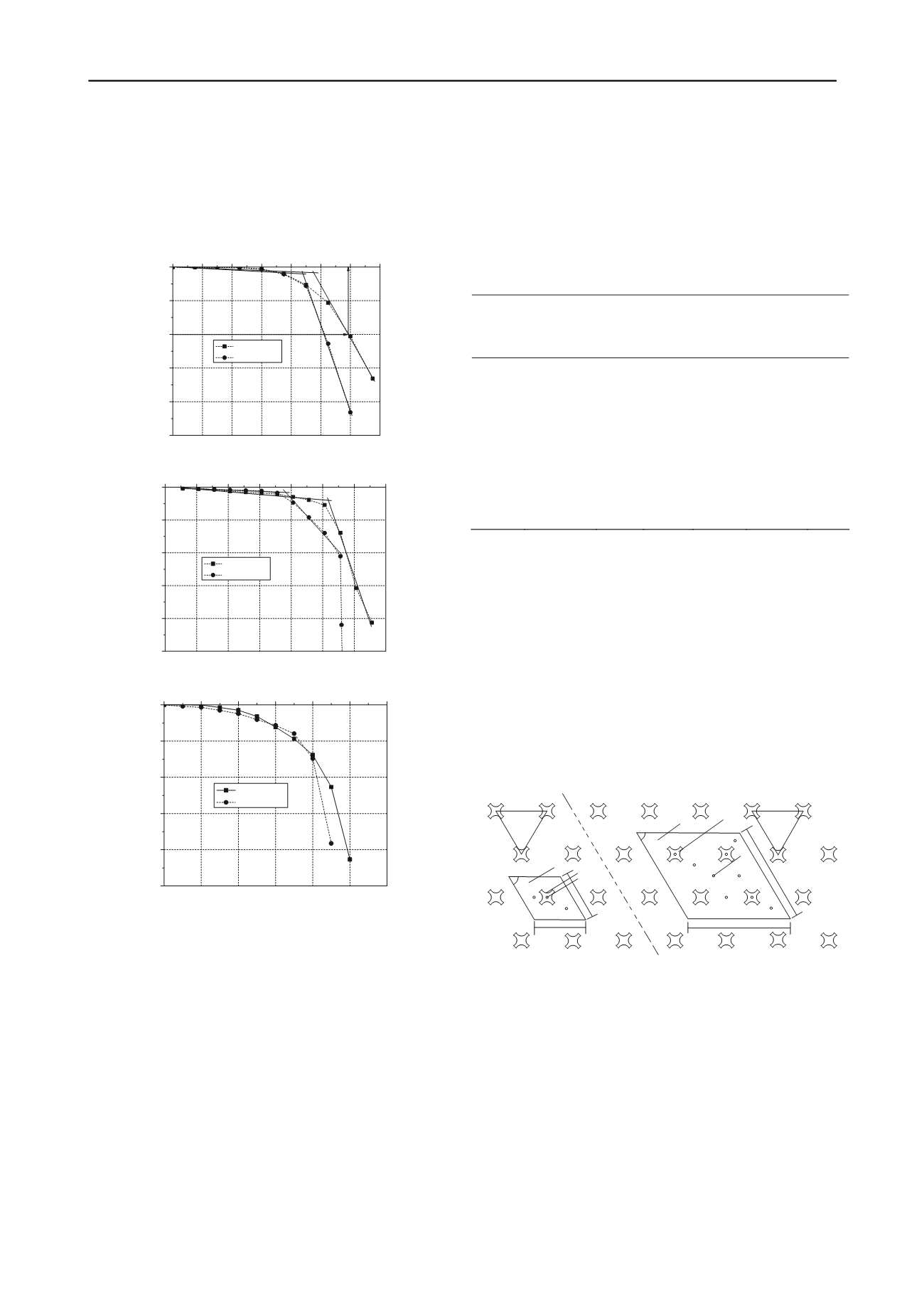
2959
Technical Committee 214 /
Comité technique 214
However, the perimeter of the circular pile is 1.338 m, which is
smaller than that of the XCC pile of 1.759 m. Thus, with the
same cross section area, the pile-soil interface contact area of
the XCC pile is 31.5 % more than that of the circular pile.
4.2 Analysis of Test Results and Discussions
100
80
60
40
20
0
0
20 40 60 80 100 120 140
(a)
XCC pile
Circular pile
Pile head compressive load,
Q
(kN)
Displacement of pile head,
s
(mm)
-100
-80
-60
-40
-20
0
-20 -30 -40 -50 -60 -70 -80 -90
(b)
XCC pile
Circular pile
Pile head uplift load,
Q
(kN)
Displacement of pile head,
s
(mm)
50
40
30
20
10
0
0
10
20
30
40
50
60
(c)
XCC pile
Circular pile
Pile head lateral load,
H
0
(kN)
Lateral displacement of pile head,
y
0
(mm)
Figure 2. The curves of load versus displacement: (a) compressive load-
displacement; (b) uplift load-displacement; (c) lateral load-displacement.
Fig. 2(a) shows load-displacement curves of the XCC pile and
the circular section pile at the pile head. The ultimate
compressive load-carrying capacity of the circular pile and XCC
pile is equal to 90 kN, and 111 kN, respectively. The ultimate
compressive capacity was improved nearly 24.0 % by changing
the pile cross section from common circular section to X-
section when the same amount of concrete volume was used.
Fig. 2(b) shows the load-displacement curves under uplift load
for the two different pile sections. The uplift capacity of XCC
pile and circular pile was found to be -70.6 kN and -56.1 kN,
respectively. The ultimate uplift capacity was improved nearly
25.8 % by changing the pile cross section from a circular
section to an X-section for the same amount of concrete volume
used. The test result of the lateral load versus lateral deflection
at pile head is plotted in Fig. 2(c) for two different pile sections.
The lateral
H
0
-
y
0
curve of XCC pile is similar with that of
circular pile. For the same lateral capacity, the amount of
concrete volume used in a XCC pile is about 6.9 % less than in
a circular pile.
5 FIELD TEST CASE STUDY
5.1 Summary of Field Test Conditions
The test site locates at north bridge of Nanjing city, where the
landform is Yangtze River floodplain. By geological
exploration, and laboratory soil test, the physical and
mechanical parameters and distribution of soil layers are shown
in Table 3.
Table 3. The soil layers and soil parameters in field test site
Soil
symbol
Name
Depth
h
(m)
Water
content
w
(%)
Unit
weight
γ
(kN/m
3
)
Modulus
E
s
(MPa)
Void
ratio
e
�
Filled
back soil
0.20
�
2
Mucky
silty clay
1.30
38.60
17.60
3.50
1.11
�
2A
Silty sand
1.00
25.30
19.20
10.77
0.70
�
2
Mucky
silty clay
1.50
38.60
17.60
3.50
1.11
�
2B
Silty sand
1.80
26.10
19.30
8.00
0.71
�
2
Mucky
silty clay
2.30
38.60
17.60
3.50
1.11
�
3
Fine sand
9.40
26.30
18.90
11.83
0.76
The pile layout in Fig. 3 shows that the piles distribute as
equilateral triangles, and the distances between two adjacent
piles for single pile test and 2×2 pile groups test equal 1.85 m,
and 1.80 m, respectively. In static loading tests of 2×2 pile
group composite foundation, the loading plates are rhombic
with side length of 3.6 m, which covers four piles. A layer of
gravel cushion with the thickness of 30 cm is paved between
pile top and loading plate. During the load tests, the total load
applied to the loading plate was measured by a load cell placed
on the loading plate, the axial force of pile shaft along pile
depth was measured by reinforcement stress meters, the soil
pressures and pile head pressures were measured by earth
pressure cells, and settlement of the pile head was recorded by
two LVDTs installed symmetrically at the loading plate. Data
from the load cells and LVDTs during the load test were
captured by a data acquisition system.
1850
1850
1800
1800
60
o
60
o
Unit: mm
3600
1850
1850
3600
1
2
3
1
3
2
1: XCC pile
2: Loading plate
3: Soil pressure cell
Figure 3. The instrument arrangements of XCC pile composite
foundation.
5.2 Analysis of Test Results and Discussions
Fig. 4 shows the changes of axial forces result in the variations
of side friction. When the load is relatively large, the side
friction from the depth of -1 m to -2 m is negative, which is the
typical characteristic of composite foundation. The load applied
on loading plate causes the non-uniform settlement between the
soil and piles. When the load is not very large, the differential
settlement is in apparent, so the negative friction is extremely
small. As the increase of the load step, the load shared by the
piles also increases, and then the pile top tends to penetrate into
the cushion, at the same time the soil subsidence occurs under


